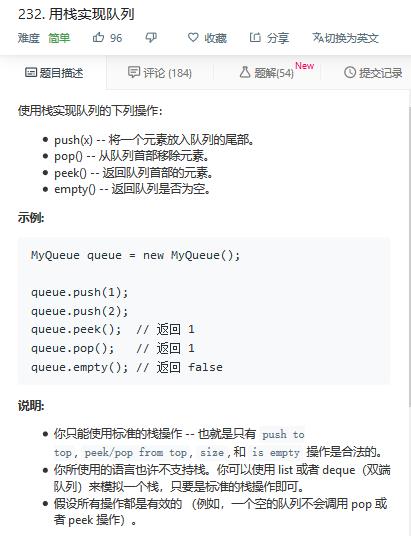leetcode-232-用栈实现队列
Posted 真不知道叫啥好
tags:
篇首语:本文由小常识网(cha138.com)小编为大家整理,主要介绍了leetcode-232-用栈实现队列相关的知识,希望对你有一定的参考价值。
题目描述:

方法一:双栈
class MyQueue: def __init__(self): """ Initialize your data structure here. """ from collections import deque self.stack = deque() def push(self, x: int) -> None: """ Push element x to the back of queue. """ tmp_stack = [] while self.stack: tmp_stack.append(self.stack.pop()) self.stack.append(x) while tmp_stack: self.stack.append(tmp_stack.pop()) def pop(self) -> int: """ Removes the element from in front of queue and returns that element. """ if self.stack: return self.stack.pop() def peek(self) -> int: """ Get the front element. """ if self.stack: return self.stack[-1] def empty(self) -> bool: """ Returns whether the queue is empty. """ return not bool(self.stack) # Your MyQueue object will be instantiated and called as such: # obj = MyQueue() # obj.push(x) # param_2 = obj.pop() # param_3 = obj.peek() # param_4 = obj.empty()
java
class CQueue { Stack<Integer> stack1; Stack<Integer> stack2; int size; public CQueue() { stack1 = new Stack<> (); stack2 = new Stack<> (); size = 0; } public void appendTail(int value) { while(!stack1.isEmpty()){ stack2.push(stack1.pop()); } stack1.push(value); while(!stack2.isEmpty()){ stack1.push(stack2.pop()); } size++; } public int deleteHead() { if(size == 0){ return -1; } size--; return stack1.pop(); } } /** * Your CQueue object will be instantiated and called as such: * CQueue obj = new CQueue(); * obj.appendTail(value); * int param_2 = obj.deleteHead(); */
以上是关于leetcode-232-用栈实现队列的主要内容,如果未能解决你的问题,请参考以下文章